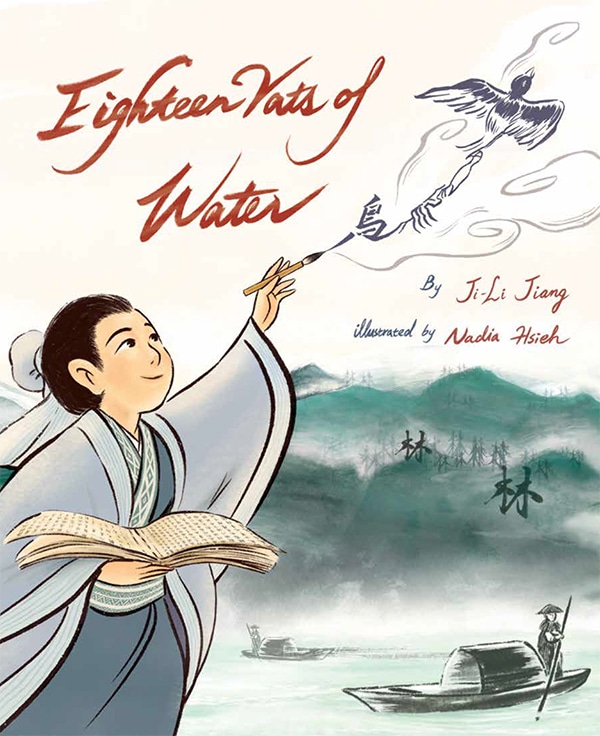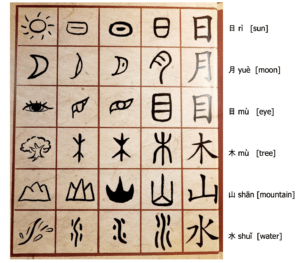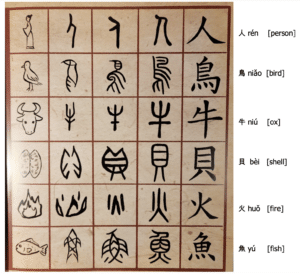
Eighteen Vats of Water
- Fiction
- Set in China
Keywords: Art, self-management, relationships, perseverance
The award-winning author of Red Scarf Girl presents another compelling true story of Chinese culture and history. As long as he can remember, Xian has wanted to be a great calligrapher like his father. Calligraphy is more than writing — it’s painting — and Xian learns how much work and creativity go into what look like effortless strokes. Based on the actual history of Xian and his famous father, Eighteen Vats of Water is about creativity, learning to see, and determination,as well as the importance of family traditions.
“Synopsis: As long as he can remember, Xian has wanted to be a great calligrapher, like his father. When he turns six, he’s finally old enough to start studying. Calligraphy is more than writing — it’s painting — and Xian learns how much work and creativity go into what look like effortless strokes. Based on stories still told about Xian and his father, famous calligraphers of the 4th century, “Eighteen Vats of Water” by the team of author/storyteller Ji-Li Jiang and artist/illustrator Nadia Hsieh is about determination, creativity, and learning how to see, as well as the importance of family traditions.
“With truly elegant illustrations in full support of an inherently interesting and original picture book story, Eighteen Vats of Water is a truly memorable and highly recommended addition to family, elementary school, and community library picture book collections for young readers.”
— Midwest Book Review
1. Chinese calligraphy
Chinese calligraphy is a crucial part of Chinese culture. Shū fǎ (书法) translates to “the way of writing” and is an art form that draws on language, history, philosophy, and aesthetics. In Chinese culture, the creation of the written language is traditionally attributed to the legendary historian Cang Jie, who was believed to have the ability to interpret and transcribe nature into writing.
The Chinese write and appreciate different kinds of calligraphy styles, using brushes and ink in both calligraphy and painting. The three fundamental elements in Chinese calligraphy are the stroke techniques, the art of composition, and the structure of Chinese characters, while the different writing styles are Regular (Standard) Script, Seal Script (also known as Small Seal), Clerical (Official), Cursive, and Semi-cursive (Running) Script. The tools used differ from Western calligraphy as Chinese calligraphy uses a brush rather than a pen.
2. Brush, ink, paper, and inkstone: the “four treasures”
The Chinese calligraphy tradition recognizes “four treasures”: brush, ink, paper, and inkstone. The most important is the brush, whose distinctive feature is its flexibility. This flexibility can be attributed to the type of animal hair from which the brush is created, such as rabbit hair (soft) and horsehair (stiff), and each brush type has a unique purpose. The size of the characters is influenced by both the length and thickness of the brush used; that is, the character size should correlate to the tuft size. Additionally, Chinese writing brushes have the important qualities of fineness, evenness, roundness, flexibility, and resilience. While the bristles are used for art, the handles are used for artistic expression and can be made from wood, bamboo, ceramics, precious metals such as gold and silver, and jade.
The two types of ink are liquid ink and ink sticks, which are made from lampblack and glue. Once ground and mixed with water, Chinese ink does not fade like Western ink does upon exposure to light, hence the long-lasting quality of Chinese calligraphic works. The viscosity of ink can be used for artistic expression as well as control of color. Contrary to the Western inkwell’s single purpose of holding ink, Chinese inkstones have multiple purposes: they can serve as paperweights, ink containers, or even as art objects. In addition, the quality of the inkstone directly affects the type and speed of ink that is ground; the smoothness/roughness of the inkstone can affect how wet the ink becomes. Lastly, the Xuan paper (often called rice paper) used in calligraphy consists of plant fibers with good surface tension, which affects how the ink appears with different strokes.
3. Various scripts and styles
The various scripts and styles in Chinese complement each other but developed at different times in Chinese history and are used for different purposes.
First, the scripts did not develop along a single chronological line. More than one script could be developed and used simultaneously. The Seal and Clerical scripts, for example, both developed around the Warring States period (403–221 BCE). Research shows that the Clerical Script was developed gradually in the pre-Qin era (221 BCE) and matured in the Han dynasty (206 BCE–220 CE).
Second, the development of the various scripts was not mutually exclusive. That is, the beginning of a new script did not define the end of an old one. The development of Regular Script, for example, helped the Cursive and Running styles mature.
Third, the exact time of the development of various scripts, especially the Regular Script, is still not settled. During the Tang dynasty (618–907), a large number of calligraphy masters brought the Regular Script to its maturity. [Reference: Li, Wendan, 2010, 100–123.] The earliest examples of Chinese writings are from the Shang dynasty (c. 1570–c. 1045
The earliest examples of Chinese writings are from the Shang dynasty (c. 1570–c. 1045 BCE), in which inscriptions on oracle bones and turtleshell were created as part of divination (hence Shell or Bone Script). About 154,000 of these oracle bones have been unearthed, from which fewer than half of the 4,700 incised characters have been deciphered.
4. The two main characters in this book
王羲之 Wáng Xīzhī [phonetic pronunciation: Wong Shee-Jer]
(303–361 CE) [Chinese calligrapher, the Sage of Calligraphy]
王献之 Wáng Xiànzhī [phonetic pronunciation: Wong Shee-an Jer]
(344–386 CE) [Chinese calligrapher, the seventh son of Wang Xizhi]
“As long as he can remember, Xian has wanted to be a great calligrapher, like his father. Calligraphy is more than writing—it’s painting—and Xian learns how much work and creativity go into what look like effortless strokes. Based on the actual story of Xian and his famous father, Eighteen Vats of Water is about determination, creativity, and learning how to see, as well as the importance of family traditions.” —from the back cover of the book.
Wang Xizhi 王羲之 (303–361 CE), known as the Sage of Calligraphy, is the most famous of all Chinese calligraphers. His work represents the summit of the art. Wang Xizhi lived in the Jin dynasty (265–420 CE). During his time, there were three major popular styles of calligraphy: Regular Script, Running Style, and Cursive Style. Wang Xizhi excelled in all three, although he was best known for his Running Style.
Running Style falls between Regular and Cursive in terms of writing speed and stroke linkage. When carefully written with distinguishable strokes, it is Regular Script; when swiftly written with indistinguishable strokes, it is Cursive. There is no doubt that Wang Xizhi became the greatest master of the Running Style because he had also mastered the Regular Script; his Running Script was firmly built on the foundation of Regular Script. Wang Xizhi passed his talent on to his sons, particularly his seventh son, Wang Xianzhi. The works of both father and son, now known as the “Two Wangs,” are among those most treasured in the tradition of Chinese calligraphy. [Reference: Li, Wendan, 2010, 131–132]
5. Calligraphy in China today
Chinese calligraphy has an important role in China. Calligraphy is written or engraved on pottery and antiquities, bridges and other large structures, and even carved into mountainsides. It is a highly prized art form, available for purchase in shops and museums. Chinese calligraphy became an important standard for imperial civil service examinations in the seventh century CE, in which anyone with good calligraphy skills (in conjunction with knowledge of other subjects) was qualified to move up the ranks of bureaucracy. Even today, good handwriting and calligraphy are valued in China, where a person’s learning, education, and personality are partly judged by their handwriting capabilities.
6. Key words from the book
书法 shū fǎ [Chinese calligraphy]
晋 Jìn [Jin (referring to the dynasty)]
王羲之 Wáng Xīzhī [phonetic pronunciation: Wang Hsi-chih]; (303-361CE) [Chinese calligrapher, the Sage of Calligraphy ]
王献之 Wáng Xiànzhī [phonetic pronunciation: Wang Hsien-chih]; (344–386 CE) [Chinese calligrapher, the seventh son of Wang Xizhi]
毛笔 máo bǐ [brush]
墨 mò [ink]
宣纸 xuānzhǐ [rice paper]
砚 yàn [inkstone]
(The following characters are inside the book cover, for students to study and try to write. Photos added)
References
Li, Wendan. Chinese Writing and Calligraphy. Honolulu: University of Hawaii Press, 2010.
Jiang, Ji-li, illustrated by Nadia Hsieh (2022). Eighteen Vats of Water. Berkeley, CA: Creston Books, 2022.
Author: Haixia Wang, Department of Modern Languages, Carnegie Mellon University & University Center for International Studies, University of Pittsburgh
2023
Chinese calligraphy is graceful and expressive, as poetic as a poem, as rhythmic as dancing, and as melodious as music.
—Eighteen Vats of Water (Author’s Note)
Appropriate for Grades: Pre-K–10. Best for Grades: Pre-K–10
Introduction to the Book
Eighteen Vats of Water is a tremendously inviting book with its beautiful illustrations, engaging story, clear themes, and imaginative use of Chinese calligraphy. At first glance, the book appears to be aimed at emergent readers—and it certainly works in that capacity, especially used as a read-aloud text for Pre-K through Grade 4. Perhaps, however, its best application is in the art (history) classrooms for Grades 5–10.
Teacher’s Note: The author’s note and illustrator’s note in the back matter are essential reading prior to using this book in the classroom.
Best Matched Curricular Unit Themes
- Chinese calligraphy (Art)
- Persistence (English)
- Illustrating with Chinese brush and ink (Art)
- Jin dynasty (History)
Essential Questions
- How does artistry hide in the everyday?
- How does abstraction add meaning to an idea?
- What is “true” persistence on the journey toward mastery?
Key Vocabulary
- Vat
- Calligraphy
- Stroke
- Jin (historical period; pronounced JEEN)
- Xian (character name; pronounced SHE-ANNE)
Essential Background Information
A. Before teaching this book, which explores the origins of Chinese characters and calligraphy, it might be worth looking at a brief video about the origins of the English alphabet. (Video: Origins of ABCs)
B. Several Chinese characters are camouflaged in the book’s illustrations. The following list provides some of the characters, their romanization, meaning, and where they can be found in the story:
王 (Wang): the protagonist’s family name (on forehead of cat)
林 (lin): forest (on wooded mountainsides)
⊙ = 日 (ri): sun (in place of the orange sun)
山 (shan): mountain (where mountains appear)
鳥 = 鸟 (niao): bird (attached to bird’s tail)
Below are several suggested cross-curricular activities, followed by several suggested discussion/writing prompts. The activities are listed in the order in which the material appears in the book.
Suggested Activities
Front Cover Examination. Before reading the book, ask the students to look at the cover. Discuss the level of abstraction for the bird as opposed to the boy. What special features do the trees have? Does anything else catch their attention?
Matching Game (Inside Front Cover). On one side of a handout, provide students with the pictures from the inside front cover (the sun, the moon, an eye, etc.), and on the other side of the handout, provide the Chinese character (日, 月, 目, etc.). Ask students to draw lines matching the pictures and the Chinese characters—making their best guesses.
Mixing Ink. Using inkstones and brushes, practice mixing inks with more or less water to see how it affects the different strokes. Find different images (frog, swan, bridge, etc.) and try different amounts of ink to draw them with Chinese calligraphy brushes.
Basic Strokes. Practice copying some of the basic Chinese strokes (Resource).
Teacher Note: to avoid ink and paper, Chinese brushes can simply be wetted with water, and students can practice writing characters on concrete or a blackboard. The water quickly evaporates, so that they can reuse the same space again and again to practice.
Hidden Chinese Character Search. Send students on a Word Search, looking for characters hidden throughout the book. The characters listed in the Essential Background Information can be included in the lists, as can characters found on the scrolls and paintings in the backgrounds.
Similar Characters — Different Meaning. Xian’s father adds a single stroke to change his son’s character from 大 (dah = big) to 太 (tie = very). Students first try to spot and describe the difference in the brushstrokes that make up these two characters. Students can write the phrase 太大了 (tie dah-luh = too big) and then draw a picture to capture the meaning of the phrase and imbue it with spirit. Advanced: They can try to hide their characters in a picture that illustrates something too big.
Paint an Animal. Each student selects an animal illustrated in the book, or they may choose their own animal to illustrate using a brushstroke technique similar to what is used in the book.
Character Scrambles (Inside Back Cover). Provide students with scrambled character sets (for example, the sun character set). Then ask students to try to put the images in order of their Chinese character development. This can lead to discussions of favorite types of characters, descriptions of the attributes of particular characters, and categorization.
Suggested Discussion/Writing Prompts
Facial Expression. Look at Xian’s facial expression when he gives his father a page of calligraphy to which his father adds a tiny stroke? How is his facial expression different from earlier in the story? What does it reveal about his attitude?
Spirit in Characters. Do you believe that every character must possess “spirit” in order to come alive on the page?
Persistence. How do characters in the story show persistence? What are some of the biggest challenges to being persistent? Is there anything you want to master that will require persistence?
Calligraphy. How is writing English different from writing Chinese? Is one more artistic than the other?
Apocryphal or True. Do you think the story of the eighteen vats is based on a true story or is it merely apocryphal? Does it matter if it is true or not?
Author: Josh Foster, educator and learner, Instructor of Film Studies and English Literature, A. Mario Loiederman Middle School for the Creative and Performing Arts, Maryland
2023
Curriculum guide available at: https://www.crestonbooks.co/eighteenvatsofwater
Selected Online Resources for Teaching with Eighteen Vats of Water
Junior Library Guild Selection
Eureka Honorable Mention
NCSS/CBC Notable Social Studies Book


